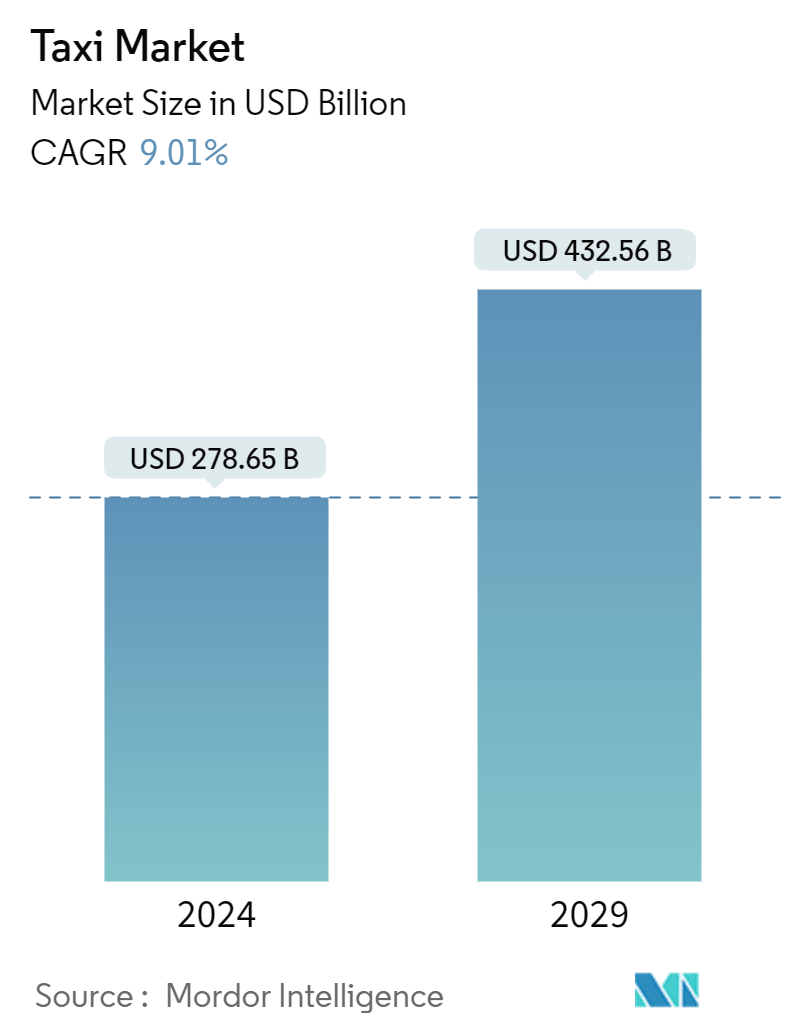Market Size of Taxi Industry

| Study Period | 2019 - 2029 |
| Market Size (2024) | USD 278.65 Billion |
| Market Size (2029) | USD 432.56 Billion |
| CAGR (2024 - 2029) | 9.01 % |
| Fastest Growing Market | Asia Pacific |
| Largest Market | Asia Pacific |
Major Players
*Disclaimer: Major Players sorted in no particular order |
Taxi Market Analysis
The Taxi Market size is estimated at USD 278.65 billion in 2024, and is expected to reach USD 432.56 billion by 2029, growing at a CAGR of 9.01% during the forecast period (2024-2029).
The taxi market has undergone substantial transformations in recent years, influenced by technological advancements, changing consumer preferences, and evolving regulatory landscapes. Taxis, once primarily hailed on the streets, have witnessed a significant shift toward app-based ride-hailing services. Companies like Uber, Lyft, and Didi Chuxing have disrupted traditional taxi models, introducing convenient and efficient ways for passengers to book rides using mobile applications.
The emergence of ride-hailing services has been a game-changer in the taxi industry. These services connect passengers with drivers through smartphone apps, offering benefits such as real-time tracking, cashless payments, and user ratings. The convenience and transparency provided by these platforms have contributed to their widespread adoption, challenging the traditional taxi dispatch system. However, this shift has also sparked debates regarding fair competition, driver rights, and regulatory concerns in various regions.
With a growing emphasis on sustainability, the taxi market is experiencing a shift toward electric vehicles (EVs). Many taxi operators and ride-hailing companies are incorporating electric or hybrid vehicles into their fleets to reduce carbon emissions and promote environmentally friendly transportation. Government incentives and regulations aimed at curbing air pollution further encourage the adoption of electric taxis, marking a significant step towards a more sustainable taxi industry.
Over the long term, the taxi industry is expected to grow due to increasing demand for ride-hailing and ride-sharing services, increasing demand from online taxi booking channels, and an increase in the cost of vehicle ownership. Compared to other modes of transportation, increasing traffic congestion and low taxi fares are the other major factors driving the taxi market.
However, the development of the industry is hampered by improvements in public transit and differing government laws on taxi services in different nations worldwide. The rise of eco-friendly electric cab services is likely to provide an attractive potential for market expansion between 2024 and 2029.
Asia-Pacific is expected to witness a considerable growth rate in the target market. This is due to the fact that the region is home to 60% of the world's population, with India and China contributing significantly to the region having the highest working population in the world.
Taxi Industry Segmentation
Taxis are a type of vehicle leasing service that includes the hiring of a driver and the vehicle. It can be used by single or multiple passengers, with the option of sharing or not sharing.
The taxi market is segmented by booking type, vehicle type, service type, and geography.
By booking type, the market is segmented into online booking and offline booking. By vehicle type, the market is segmented into motorcycles, cars, and other vehicle types (vans). By service type, the market is segmented into ride-hailing and ride-sharing.
By geography, the market is segmented into North America, Europe, Asia-Pacific, and Rest of the World. The report covers the market size and forecasts the value (USD Billion) for all the above segments.
| Booking Type | |
| Online Booking | |
| Offline Booking |
| Service Type | |
| Ride-hailing | |
| Ride-sharing |
| Vehicle Type | |
| Motorcycle | |
| Cars | |
| Other Vehicle Types (Vans) |
| Geography | |||||||||
| |||||||||
| |||||||||
| |||||||||
|
Taxi Market Size Summary
The taxi market is experiencing significant evolution, driven by technological advancements and shifting consumer preferences. The rise of app-based ride-hailing services like Uber, Lyft, and Didi Chuxing has transformed traditional taxi models, offering passengers convenient features such as real-time tracking and cashless payments. This shift has challenged conventional taxi dispatch systems and sparked discussions on competition, driver rights, and regulatory issues. Additionally, the industry is increasingly focusing on sustainability, with many operators incorporating electric and hybrid vehicles into their fleets to reduce carbon emissions. Government incentives and regulations further support this transition towards a more environmentally friendly taxi industry.
The market is poised for growth, fueled by the increasing demand for ride-hailing and ride-sharing services, as well as the rising popularity of online taxi booking platforms. The Asia-Pacific region, home to a significant portion of the world's population, is expected to witness substantial growth due to its high smartphone penetration and traffic congestion. Major players like DiDi Chuxing, Ola, and Grab are leveraging technology to expand their market share, while the introduction of bike taxis offers a cost-effective alternative in congested urban areas. Despite challenges from public transit improvements and varying government regulations, the taxi industry is set to expand, with electric and ride-sharing services presenting promising opportunities for future growth.
Taxi Market Size - Table of Contents
-
1. MARKET DYNAMICS
-
1.1 Market Drivers
-
1.2 Market Restraints
-
1.3 Industry Attractiveness - Porter's Five Forces Analysis
-
1.3.1 Threat of New Entrants
-
1.3.2 Bargaining Power of Buyers/Consumers
-
1.3.3 Bargaining Power of Suppliers
-
1.3.4 Threat of Substitute Products
-
1.3.5 Intensity of Competitive Rivalry
-
-
-
2. MARKET SEGMENTATION
-
2.1 Booking Type
-
2.1.1 Online Booking
-
2.1.2 Offline Booking
-
-
2.2 Service Type
-
2.2.1 Ride-hailing
-
2.2.2 Ride-sharing
-
-
2.3 Vehicle Type
-
2.3.1 Motorcycle
-
2.3.2 Cars
-
2.3.3 Other Vehicle Types (Vans)
-
-
2.4 Geography
-
2.4.1 North America
-
2.4.1.1 United States
-
2.4.1.2 Canada
-
2.4.1.3 Rest of North America
-
-
2.4.2 Europe
-
2.4.2.1 Germany
-
2.4.2.2 United Kingdom
-
2.4.2.3 France
-
2.4.2.4 Spain
-
2.4.2.5 Rest of Europe
-
-
2.4.3 Asia-Pacific
-
2.4.3.1 China
-
2.4.3.2 India
-
2.4.3.3 Japan
-
2.4.3.4 Australia
-
2.4.3.5 Vietnam
-
2.4.3.6 South Korea
-
2.4.3.7 Rest of Asia-Pacific
-
-
2.4.4 Rest of the World
-
2.4.4.1 Mexico
-
2.4.4.2 Brazil
-
2.4.4.3 South Africa
-
2.4.4.4 Argentina
-
2.4.4.5 Other Countries
-
-
-
Taxi Market Size FAQs
How big is the Taxi Market?
The Taxi Market size is expected to reach USD 278.65 billion in 2024 and grow at a CAGR of 9.01% to reach USD 432.56 billion by 2029.
What is the current Taxi Market size?
In 2024, the Taxi Market size is expected to reach USD 278.65 billion.

